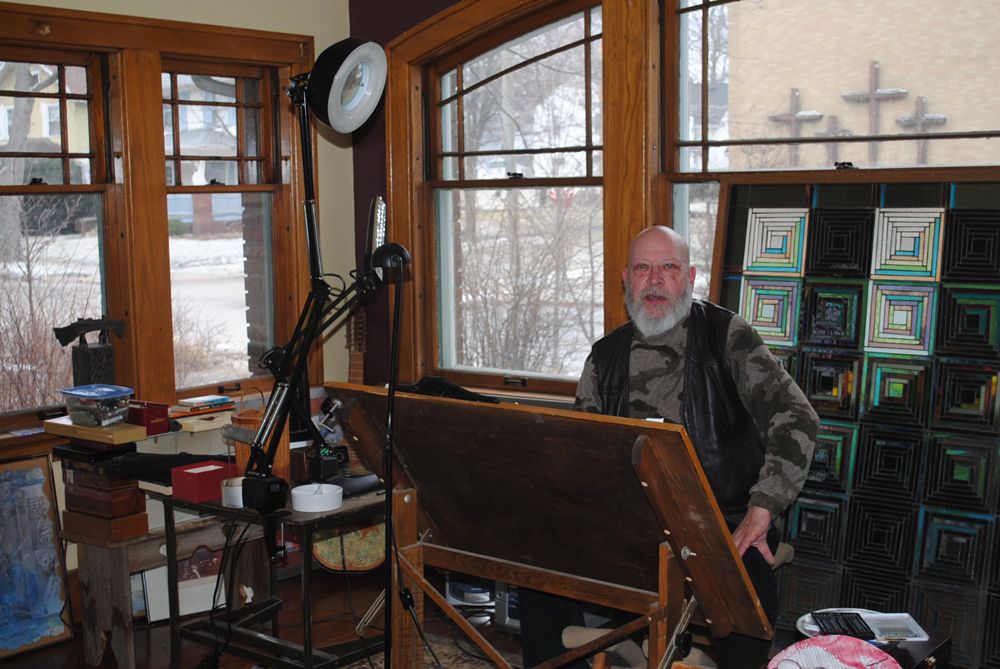The first glance at Gregg Coffey’s work elicits almost too many thoughts to handle. There are bright colors, geometric lines, abstract shapes, political undertones, earthy, ancient figures and the list goes on. Stare longer at the pieces, and these details begin to make a little more sense, though they remain well shrouded in mystery. “I continue to rework the themes of nature, quantum physics, Asian and Celtic themes, as well as work inspired by some of my favorite writers like H.P. Lovecraft,” said Coffey in an email interview.
Coffey, a former law clerk, spent many years studying formal Chinese painting instruction and later the Book of Kells and Celtic interlacing. Herein lie some answers about what exactly is going on in each of these complicated, meticulous fine art pieces. Knowing this helps us understand how Coffey creates what he does, but it does little to tell us why.
On the other hand, art doesn’t have to make sense. Bring skeptics to an art museum and they probably “won’t get” most of the pieces hanging on the wall or sitting on the floor. Bring an art critic into the same exhibit and he may very well say the same thing, “I don’t get it.” All that really matters is that they both say, “I like it!”
On the other end, through the artist’s lens, the work may better suit the audience and art itself if it is actually understood. Pair understanding and aesthetic admiration and you have a winning match.
“I guess I use detail because I had a science background before art,” Coffey said. “My school counselors tried to steer me into medical illustration. My biology teacher accused me of stealing an illustration from a book. My parents had to come in and convince the school that it was, in fact, my illustration.”
With so much going on in Coffey’s work, it’s okay not to understand some – or even any – of it. But if you don’t have a reaction, then your eyes aren’t open. The bright colors, one blending into the other in the background, says something. The cow wearing spectacles with a “Have you seen this child?” tattoo on its udder says something. The European and Asian influences coexisting brilliantly in the same space says something. It’s up to you to decide what that something is.
“I became interested in art in grade school, and my first drawings were of experimental car prototypes. My dad was a car dealer, and he had taken me to Detroit to see the roll-out of the new models, and there were many futuristic prototypes at the show,” said Coffey.
And the spark was born. As a child we have impressionable minds, that’s no secret. So put yourself in Coffey’s shoes and imagine futuristic, shiny, metal cars being unveiled, and try not to let your imagination flourish.
There is definitely a childlike quality to Coffey’s etching entitled “Floating Horticulture.” The deep, dark blues only let the giant flowers, flying fish, waves and lanterns on the piece pop. There are human figures in many different poses throughout and the mountain in the background along with those giant flowers on the right and the waves in the foreground let the setting of “Floating Horticulture” become a mystic scene. It’s like a whimsical, dark children’s book. With influences like Max Ernst and Roberto Matta, it’s easy to see how Coffey’s work is so storybook-like while remaining well away from simplicity or innocence.
The Asian influences of Chang Dai Chien and Lui Sang Wong also help us to understand where each detail of Coffey’s work is coming from and how it’s being mixed with more Western influences to create his elaborate and fantastical work.
At first you see the colors with Coffey’s “Mining for Prima Materia.” Earthy greens and vibrant oranges make up the majority of these colors, but some deep blues and subtle tans help to bring the piece to dynamic life. With lines shooting in from the corners and a grid forming the lower half, you almost lose sight (literally) of the other elements which include waves, swirls, stones, and of course the mythical Cyclops and gargoyle-looking creatures. Individually none of these components says too much, but together they say quite a lot, and all at once. It’s up to the viewer to decipher exactly what they’re saying. And that’s the fun part.
The map-like quality of “The New New Brendan Voyage” is perhaps the defining feature of this mixed media on paper, a favorite medium of Coffey’s. This map-like feature shows up again and again throughout Coffey’s work. In the aforementioned “Sublime Bovine Persuasion” piece, the cow’s spots are landmasses. This quality adds a sense of adventure, a sense of journey to Coffey’s work. If you unearthed one of Coffey’s pieces from the dirt beneath a tree marked with an X, you’d have a non-decipherable puzzle map on your hands. Instead of some fake pirate map, however, you’d have fine, detailed art meant for the walls of a collector or, of course, a gallery.
Among some of the other details in “Sublime Bovine Persuasion” that take up space on the cow’s hide like rainbows, waves with some type of serpentine figure sliding in and out, a fish and a compass, you also get out-of-the-box elements in this mixed media on paper piece like a head on a plate and a dissected fashion dummy. This all gives the viewer quite a lot to take in. You find yourself saying, “What does all this have to do with each other?” over “What is this?” more times than not.
What each of Coffey’s piece is saying is beyond comprehension at times, but don’t let that take away the talent that presents itself in shining notes with each creation. Take in each detail. Let your eyes scan from edge to edge. Put meaning on what you want, what you can, and let the rest add to the sum of the mystery.
 Submit Your Event
Submit Your Event
